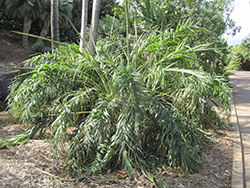It's all about ...
plants

Height: 6 feet
Spread: 10 feet
Sunlight:
![]()
![]()
Hardiness Zone: 9b
Description:
An attractive stemless to short stemmed palm featuring deep green foliage with prominent mid-ribs, that gracefully arch outwards; seasonal yellow flower spikes; very tolerant of coastal exposure, salty air and soil, and is also cold and heat tolerant
Ornamental Features
Seashore Palm features bold spikes of buttery yellow flowers with yellow overtones rising above the foliage from late fall to late winter. It has attractive dark green foliage with pointy creamy white spines. The glossy narrow pinnately compound leaves are highly ornamental and remain dark green throughout the winter.
Landscape Attributes
Seashore Palm is a multi-stemmed evergreen shrub with a shapely form and gracefully arching branches. Its relatively coarse texture can be used to stand it apart from other landscape plants with finer foliage.
This shrub will require occasional maintenance and upkeep, and can be pruned at anytime. It is a good choice for attracting bees and butterflies to your yard, but is not particularly attractive to deer who tend to leave it alone in favor of tastier treats. It has no significant negative characteristics.
Seashore Palm is recommended for the following landscape applications;
- Accent
- Hedges/Screening
- Naturalizing And Woodland Gardens
- Container Planting
Planting & Growing
Seashore Palm will grow to be about 6 feet tall at maturity, with a spread of 10 feet. It has a low canopy, and is suitable for planting under power lines. It grows at a slow rate, and under ideal conditions can be expected to live for 40 years or more.
This shrub does best in full sun to partial shade. It is very adaptable to both dry and moist growing conditions, but will not tolerate any standing water. It is not particular as to soil pH, but grows best in sandy soils, and is able to handle environmental salt. It is somewhat tolerant of urban pollution. This species is not originally from North America.
Seashore Palm makes a fine choice for the outdoor landscape, but it is also well-suited for use in outdoor pots and containers. Because of its height, it is often used as a 'thriller' in the 'spiller-thriller-filler' container combination; plant it near the center of the pot, surrounded by smaller plants and those that spill over the edges. It is even sizeable enough that it can be grown alone in a suitable container. Note that when grown in a container, it may not perform exactly as indicated on the tag - this is to be expected. Also note that when growing plants in outdoor containers and baskets, they may require more frequent waterings than they would in the yard or garden. Be aware that in our climate, most plants cannot be expected to survive the winter if left in containers outdoors, and this plant is no exception. Contact our experts for more information on how to protect it over the winter months.
This plant is not reliably hardy in our region, and certain restrictions may apply; contact the store for more information.
